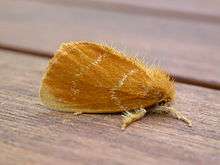Euproctis lutea
| Euproctis lutea | |
|---|---|
 | |
 | |
| Scientific classification | |
| Kingdom: | Animalia |
| Phylum: | Arthropoda |
| Class: | Insecta |
| Order: | Lepidoptera |
| Family: | Lymantriidae |
| Genus: | Euproctis |
| Species: | E. lutea |
| Binomial name | |
| Euproctis lutea (Fabricius, 1775)[1] | |
| Synonyms | |
| |
Euproctis lutea is a species of moth of the Lymantriidae family. It is found in northern Australia (the Northern Territory, Queensland and New South Wales) and New Guinea.
The wingspan is about 30 mm. The forewings are yellow with two faint zigzag lines. The hindwings are plain yellow.[2]
The larvae feed on Lycopersicum esculentum, Begonia species, Myosotis arvensis, Rosa odorata, Barringtonia acutangula and Planchonia careya. They are black and hairy, with a wide white line running along the length of the abdomen, and a wide white spot on the thorax. Full-grown larvae reach a length of about 15 mm. Pupation takes place in a sparse cocoon in a sheltered location away from the food plant.
References
| Wikispecies has information related to: Euproctis lutea |
| Wikimedia Commons has media related to Euproctis lutea. |
This article is issued from Wikipedia - version of the Friday, August 15, 2014. The text is available under the Creative Commons Attribution/Share Alike but additional terms may apply for the media files.